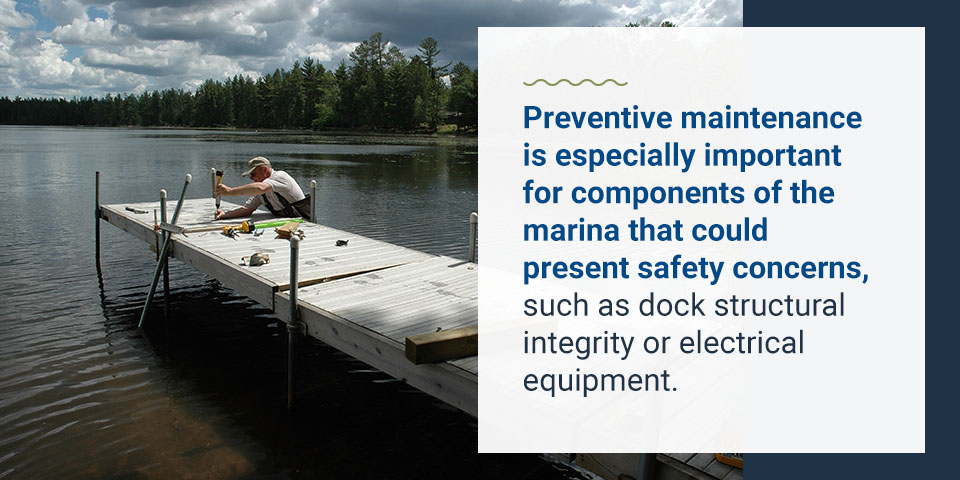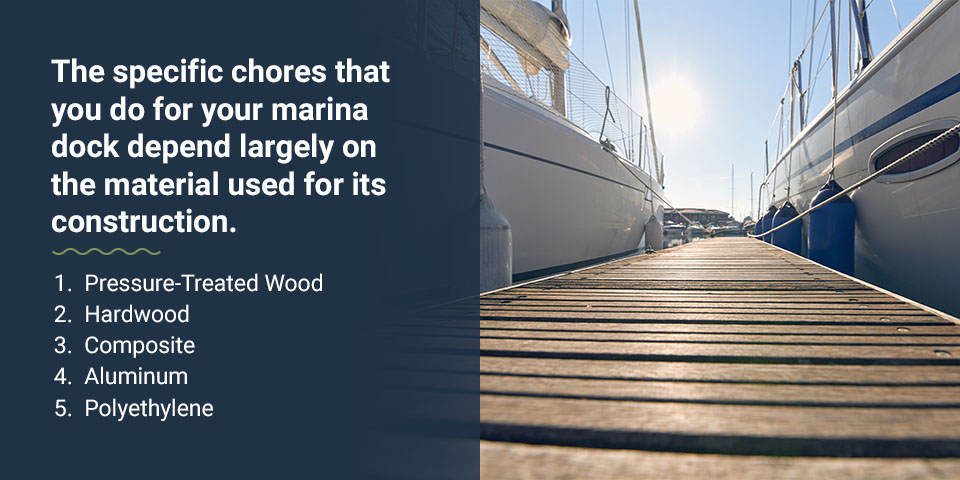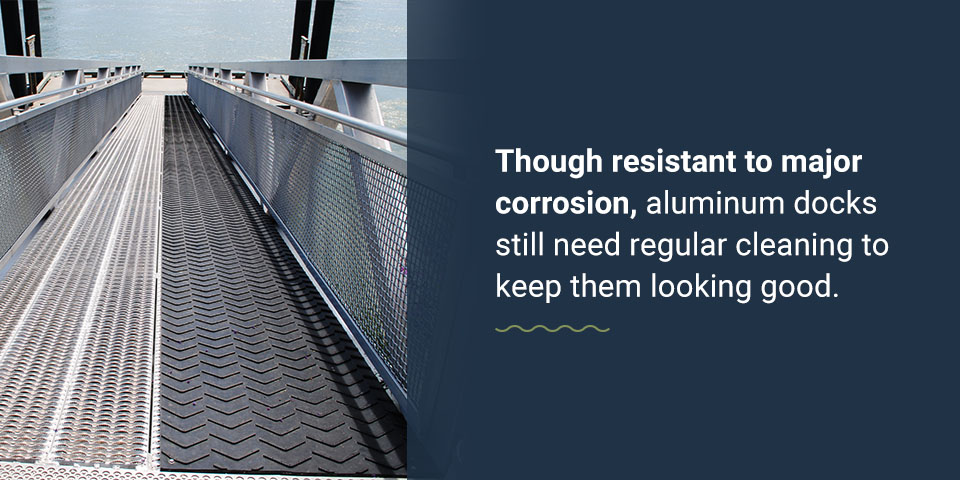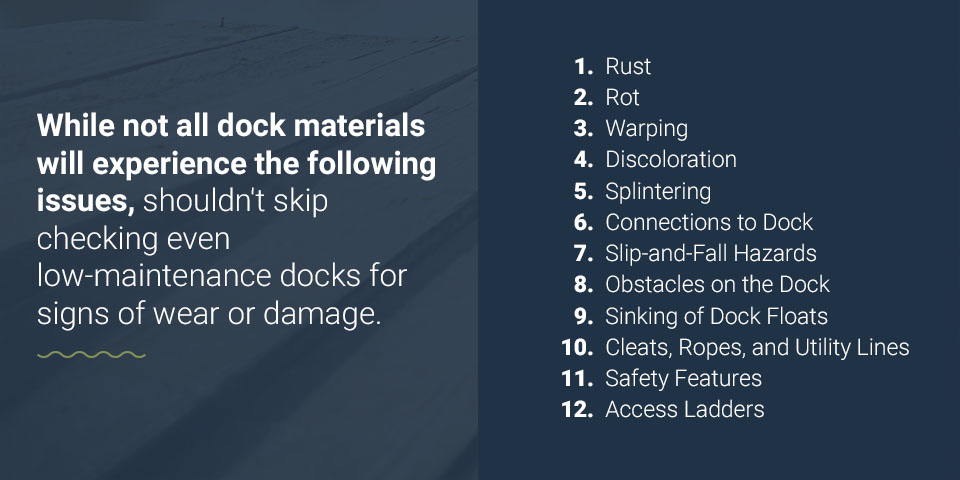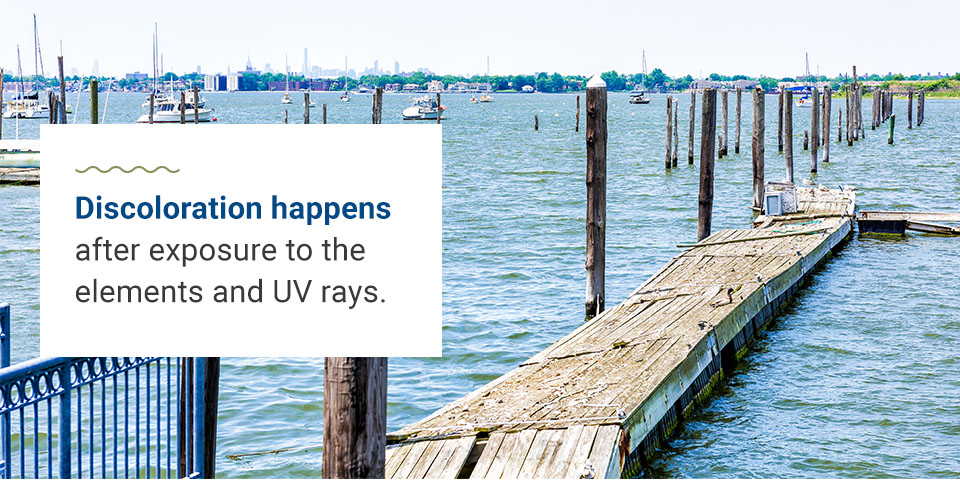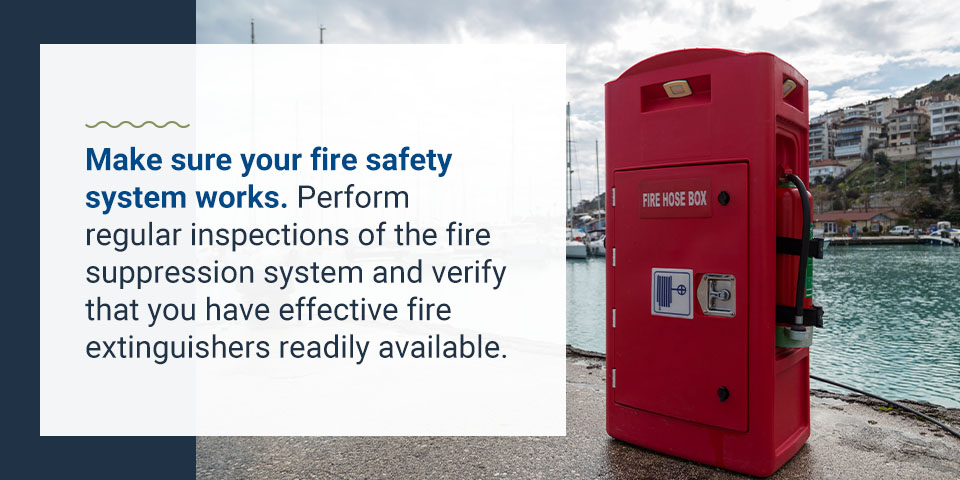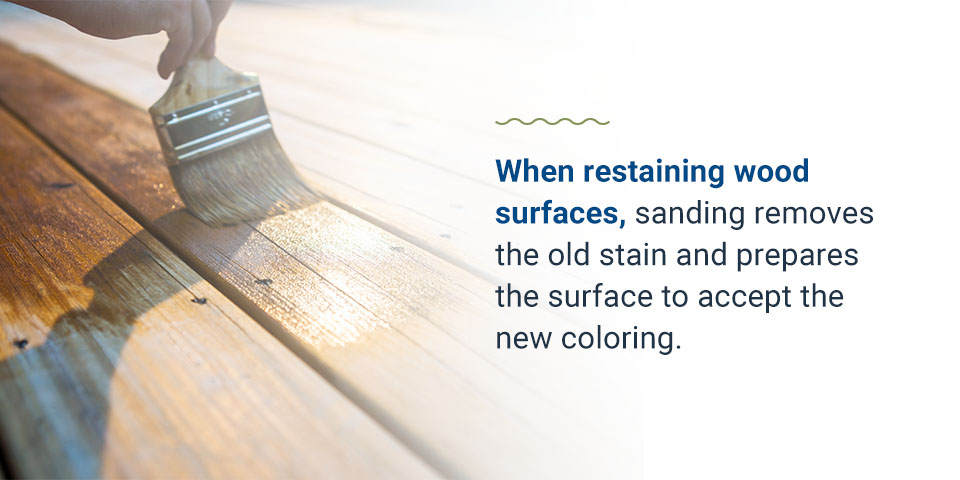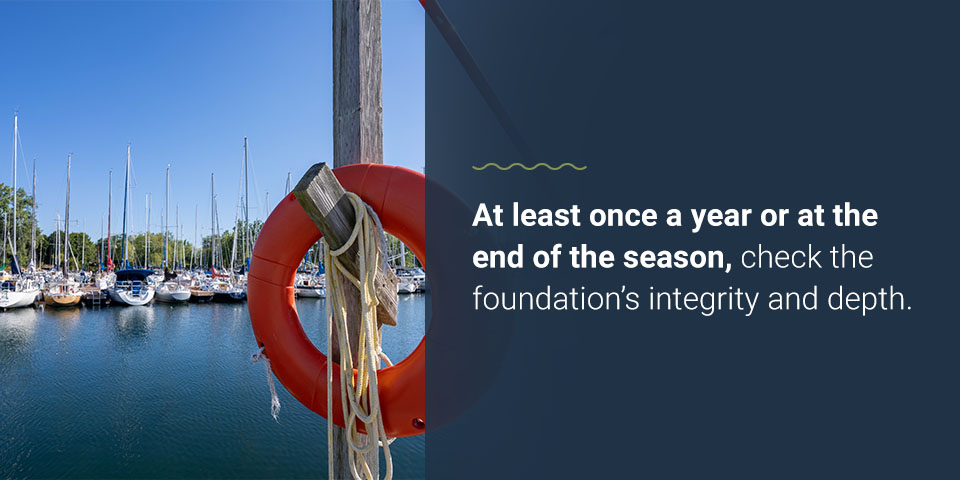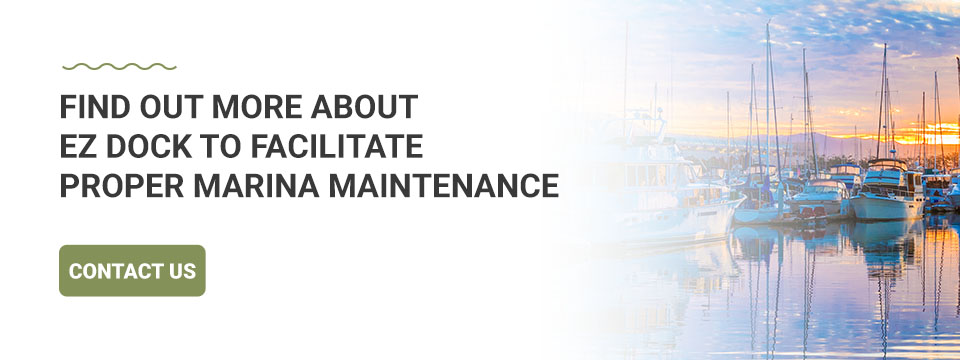Filters
Guide to Maintaining Your Marina
Properly maintaining a marina is essential to prevent problems caused by neglect or inadequate care. Frequent cleaning and servicing of the dock and other components will keep the area clean, healthy and safe.
When you make the following maintenance chores part of your regular routine, you’ll help ensure the longevity of your marina and the satisfaction of those who use it.
Perform a Weekly Visual Inspection
One of the most important marina maintenance tips is to check the area weekly. Doing regular inspections allows you to identify small problems before they grow into major service disruptors. These inspections are a form of preventive maintenance, which helps you avoid problems rather than pay for costly repairs after serious issues develop. Preventive maintenance is especially important for components of the marina that could present safety concerns, such as dock structural integrity or electrical equipment.
Water and electricity are incompatible, so you’ll need to frequently check the electrical system at your marina. Your weekly visual inspection should include looking over the electrical components to see if there are signs of corrosion, missing components or damage. Saltwater spray can lead to corrosion and any water may cause shorts or rust. Look out for these issues in the electrical components. If you find any problems with electrical systems, such as flicking lights, get them repaired immediately.
Another task for your weekly inspection is examining the dock for signs of damage from accidents. Short-term damage to docks likely doesn’t come from sun or precipitation exposure. Even if a boating accident does not cause visible damage, close off the dock and carefully inspect its structural integrity, including the foundation. Damage that could cause a safety issue may not immediately be apparent.
If a storm passes through your area, inspect your docks to see if the wind or wave-tossed debris caused damage to any of the docks or components. Also, check your marina equipment following a storm to ensure that they’ll work as intended when people return to the marina, such as boat winches and lifts.
These visual inspections should not take the place of more thorough examinations of your marina equipment and structures. Conduct regular cleanings and services at scheduled intervals, depending on the task. Some chores you should do before and after the season while others require you to conduct them monthly or annually. Other chores depend on the type of dock your marina has for its dock type, its amenities and other features.
Consider Your Dock Material
The specific chores that you do for your marina dock depend largely on the material used for its construction. Some dock materials require much less maintenance than others, which is why you should know different dock materials and the most common issues associated with each. This knowledge will help you create a customized cleaning and care schedule to keep your marina docks safe and secure throughout the season and for continued use into the future.
1. Pressure-Treated Wood
Pressure-treated wood is a cost-effective material for docks. This type of wood requires regular sealing to keep out moisture that can create rot. Pressure-treated wood docks can develop several issues that other types of wood docks have, such as splinters and rot. If your dock uses “marine-grade” pressure-treated wood, it will likely last longer than docks not made from this extra-hardy style.
2. Hardwood
Hardwoods are dense, durable woods that resist rot, insect invasion and wear. One common type of hardwood for decking is ipe, which is the common name for ironwood or Brazilian walnut. If you have a hardwood dock, you’ll enjoy years of use as long as you regularly keep the dock oiled and cleaned to protect the surface.
3. Composite
Composite material is another durable option. This material uses a combination of wood fibers and plastics to create a blend of materials that last a long time and need only simple maintenance. Some brands may include resin surfaces to prevent mildew and decay and are as durable as some hardwoods.
4. Aluminum
Aluminum is a lightweight metal that does not rot or experience bug infestations. However, aluminum can corrode if not kept clean. When exposed to the elements, aluminum can also oxidize. You may coat the surface with a lacquer to prevent this damage to the dock’s appearance. Though resistant to major corrosion, aluminum docks still need regular cleaning to keep them looking good.
5. Polyethylene
Polyethylene is a type of plastic that solves many of the problems associated with other types of dock material. Docks made with polyethylene do not rot, rust, warp, corrode or need painting. Aside from typical cleaning, this material is almost maintenance-free. However, you should still check dock connections and the dock floats when using polyethylene floating docks at your marina.
Common Issues to Check Out
When looking over your docks, watch out for the most common problems. While not all dock materials will experience the following issues, you shouldn’t skip checking even low-maintenance docks for signs of wear or damage. These regular preventive checks will keep your marina docks looking good, operating properly and staying safe for those who use your facility.
1. Rust
Rust or corrosion can occur on aluminum docks or the metal parts of other docks. Watch out for signs of discoloration or wear in any of your dock’s metal components. Rust compromises the integrity of the metal, especially if left unremoved. Clean off small amounts of rust with vinegar. If you have severely corroded parts that could make your dock unsafe, replace those sections as soon as possible. Use corrosion-resistant alternatives to replace rusted parts or seal the components to prevent the problem in the future.
2. Rot
Wood rot may happen when you don’t properly seal wood docks. This issue is especially common with docks in saltwater. The best way to prevent the problem is to treat your wood dock with sealant or oil. If you see rotted wood anywhere on the dock, remove the affected parts and replace them with new lumber pieces at once.
3. Warping
Wood warps when it’s exposed to water. Check for warping or bending parts of your wood dock, especially at the start of the operating season. If you detect minor bending, you might clamp the wood down until it restores its flat shape. However, for severe warping, especially when the bends cause trip hazards, replace the wood to prevent additional problems.
4. Discoloration
Discoloration happens after exposure to the elements and UV rays. after exposure to the elements and UV rays. Wood docks start to take on a silvery or grayish appearance. This discoloration makes your docks look old and poorly cared for. Regular sanding, staining or oiling of hardwood docks or sealing of other wood dock types can restore the appearance of your marina dock’s surface.
5. Splintering
Splinters plague wood decks regularly. These wood splits are painful hazards for those walking along the dock barefoot. Sanding wood docks will remove splinters and keep the surface smooth. Frequent care with sealant or oil and cleaning can also prevent the wood from splintering. However, if you see multiple splinters within a single board, replace the wood with a new piece.
6. Connections to Dock
Check that all dock connections are firmly attached and intact, including couplers, handrails and gangways. Replace damaged connections at any section of the dock to keep the unit safe and secure. You should also look for signs of rust or damage on metal connections to the dock and replace those components as necessary.
7. Slip-and-Fall Hazards
Slipping hazards include wet, slick surfaces, spilled materials and loose boards. Inspect your docks regularly for these types of dangers and correct them as soon as possible. Falls from docks are more dangerous than typical stumbles because the person who trips could fall into the water and risk drowning. Post signage to prevent running, jumping and swimming in the marina and help reduce accidents.
8. Obstacles on the Dock
Obstacles on the dock may include trash, cargo, machinery, lost articles or nails in the boards. These objects may cause people to trip or otherwise injure themselves on the dock. Certain items also create fire hazards if people can’t quickly and safely evacuate the marina via the docks in case of an emergency.
An exposed nail, even if it has a flat nailhead, can still cut or impale a foot that steps directly on top of it. For wooden docks, check for nails that have been pulled out and hammer them back into place or replace them.
Remove other objects from docks and place proper signage to keep the docks clear.
9. Sinking of Dock Floats
If you have floating docks, check the condition of the dock floats. You shouldn’t need to look too closely at the floats to find out whether a problem exists. Sinking parts of a floating dock indicate an issue with the corresponding dock float. Repair the float to restore the dock to safe use.
10. Cleats, Ropes and Utility Lines
Look over the security of cleats on the dock. Examine the cleats, ropes and utility lines daily to ensure they’re intact, securely in place and not blocking pathways. Resecure any component that isn’t firmly in place.
11. Safety Features
Make sure your fire safety system works. Perform regular inspections of the fire suppression system and verify that you have effective fire extinguishers readily available. You should also check that you have life-saving floatation devices on your dock. Unless otherwise specified by local ordinances, place a floatation device with a 60-foot, 3/4-inch diameter rope every 200 feet along docks. Use only devices approved by the United States Coast Guard for your throwable floatation rescue devices.
12. Access Ladders
Look over the integrity of access ladders to your docks. Make sure you have securely attached ladders to the docks and keep them well-maintained. Repair any damage to these ladders or replace broken ladders at once. You should also regularly check for signs of loose or missing hardware on the ladders and repair these components.
Sand and Stain Your Dock
Sanding removes splinters from the surface of a wood dock. When restaining wood surfaces, sanding removes the old stain and prepares the surface to accept the new coloring. Schedule restaining after your annual dock deep cleaning. Set up these chores at the end of the season when marina water levels are lowest. This timing gives you access to more of the dock’s wood.
If your marina experiences harsh winter conditions, you might clean, sand and stain the dock after the winter to freshen its appearance for the coming season. Choose a waterproof, low volatile organic compound (VOC) stain for the surface. If possible, opt for an environmentally friendly stain that will not negatively impact the water’s ecosystem. Wait for dry, still weather to stain the deck. Wind-blown water, rain or water lapping onto the dock may impact the quality of the stain or its ability to dry quickly.
Learn When You Should Replace Your Dock
It’s essential to learn the signs of when your dock needs repairs compared to when it requires replacement. Minor repairs can keep your dock intact and looking good temporarily. However, many docks, especially wooden ones, will eventually need complete replacement.
If multiple boards of your dock require replacement due to widespread rot, replace the entire dock. If you have excessive rot or rust and replacing a couple of boards isn’t an adequate fix, the signs indicate your dock has reached the end of its usefulness. Unkept docks will require replacement sooner than well-cared-for docks.
Another sign to replace the entire dock is severe damage to the foundation. Wood foundations underwater will experience faster rot from water and fauna than parts of the dock above the surface. Dock posts should be set at least four feet into the ground. If your existing dock doesn’t meet these standards, you must replace the dock and its foundation.
Deep Clean Annually
Annual deep cleaning of a dock removes dirt build-up and algae. For almost all types of docks, a brush and environmentally friendly cleaner will suffice for getting rid of surface stains. Baking soda works well to clean off aluminum docks. Deeply embedded stains in wooden docks require cleaning, sanding and restaining. Never pressure wash wooden docks. The high pressure of the water will damage the wood, causing it to splinter and wear prematurely.
For polyethylene docks, feel free to use pressure washers to get rid of deep dirt or algae. These types of docks are sturdier than wood docks and can stand up to the rigors of pressure washing.
Inspect Electrical Components Monthly
A weekly visual inspection of electrical components can detect issues such as tangled cords, corrosion, improper use of equipment, damaged cords or electrical housing, signs of previous electrical fires or missing parts. Augment this brief examination of the electrical system with a more thorough monthly check of the components.
Once a month, check that electrical panels and power centers operate at the necessary voltage and work as expected. You should conduct this tactile examination before the season starts if you have a seasonal marina.
Once a year, conduct ground resistance testing and infrared imaging of all electrical equipment. These in-depth tests of your equipment can spot problems that visual or tactile inspections might miss and ensure the extended safety of your electrical system.
Check the Foundation
The state of your dock’s foundation is important to determine whether to keep or replace a dock. At least once a year or at the end of the season, check the foundation’s integrity and depth. If the dock posts don’t set at least four feet into the ground, replace the dock and its foundation. A foundation with that amount of wear will likely indicate a damaged dock, too.
Make Sure the Equipment Works Properly
Check overall equipment at the end of each season. Use the off-season to replace worn lifts or winches or make repairs. At the start of the season, do another examination of the equipment to ensure that all parts work as expected. Properly working equipment will ensure that those who use your marina don’t experience problems when setting off for a day on the water.
When checking the operation of equipment around the marina, also verify that your safety signage is intact and legible. You may need to replace worn or broken signs. Your marina signage should include listings of your rules, safety contact information, the locations of AEDs and first aid kits and warnings against swimming in the marina. If you have a fuel dock, post signage to prohibit smoking in the area.
Look Over Cleats and Other Dock Components Regularly
Check that each slip has secured cleats. Replace missing cleats and tighten those that become loose. You should also for signs of damage on any boat bumpers you have and replace bumpers with tears on the surface.
At the end of the season when you’re pulling in floating docks, examine the floatation parts. When these components use foam, ensure they have a complete enclosure around the foam to protect the water environment. For other types of floats, check that they hold the dock at the appropriate level above the water. The sections should be intact and even.
Frequently Empty Trash Receptacles
Make emptying trash receptacles a daily chore for your marina workers. During the height of the season, you may need to do this job twice daily. Once a day may suffice for slower periods. Trash bins attract rats, bugs, wildlife and other pests to the area. Emptying bins at the end of the day discourages wildlife from coming to your marina after dark looking for trash can contents and potentially causing damage to docks, boats and equipment.
During the day, never let the trash bins overflow. Full trash cans encourage people to drop their litter on the ground because they don’t have a place to put their trash. This litter may fall into the water and harm the environment. Trash around the marina also makes the space look unkempt and poses slip-and-fall hazards.
Watch for Policy Violations
Lastly, keep an eye out for guests violating your marina policies. Your rules and regulations help preserve the environment, guest safety and the integrity of your marina. Train employees at the marina to watch for and report those visitors who violate policies.
Always follow through with stated consequences for policy violators. For marina use agreements, write out what will happen to those who use your space and break rules. You may use a tiered system that includes a warning on the first violation and suspension from the marina on subsequent violations. While this method requires tracking those who break the rules, it’ll protect the others who use your marina from unsafe behaviors.
Find Out More About EZ Dock to Facilitate Proper Marina Maintenance
If you want to reduce the work required to maintain your marina, choose polyethylene docks from EZ Dock. Our company has provided modular floating docks to marina owners and others for more than 26 years. The construction of our docks ensures that you won’t need to put extra work into preserving their integrity. The material won’t rot or splinter and doesn’t need repainting.
Our low-maintenance docks are durable and last for years. Incorporate these polyethylene docks into your marina if you want a stronger and more appealing solution. Make the move to upgrade your marina today with a carefree EZ Dock product. Contact us today to find out more about us and our line of long-lasting dock products.


